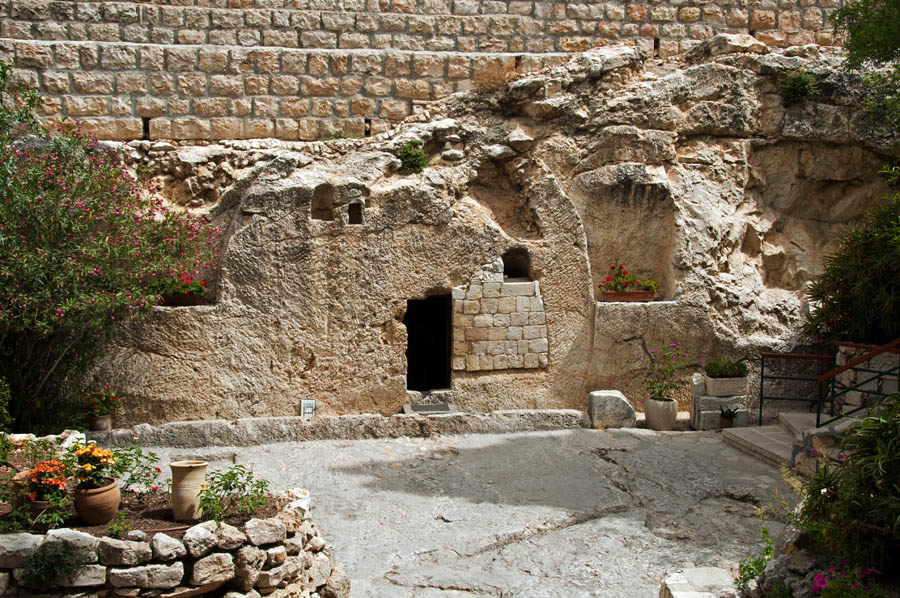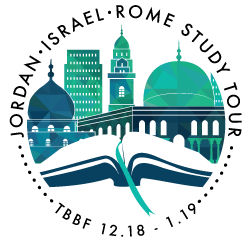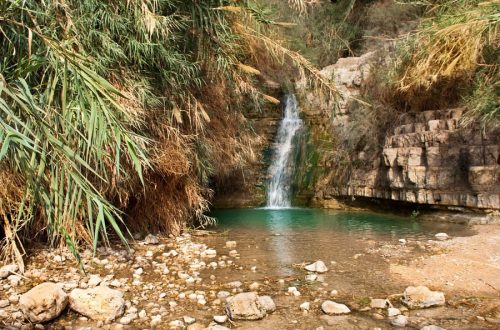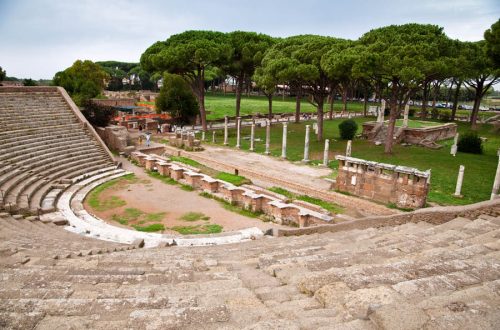Upper Room

Also known as The Cenacle (Latin: cenaculum, from cena meaning supper) this is the traditional site of the Last Supper. This large upper room was probably part of the home of Mark’s parents, and was also the site where the Apostles often gathered. It was here that Jesus and His disciples ate the final Passover, where Jesus washed the disciples’ feet, where Judas was identified as the betrayer, where the Apostles later gathered after the resurrection, where Matthias was elected to join their number, and where the Holy Spirit descended on Pentecost. People marvel at its exquisite architecture.
House of Caiaphas
Caiaphas was High Priest when Jesus was arrested and it was to his house that Jesus was first taken for what would be the first trial (Matthew 27:57ff). It was also here, in the outer courtyard, that Peter’s three denials took place (Matthew 26:69 ff). Today a church – St. Peter in Gallicantu which means “the crowing of the cock – is built over the remains of the house, which include the original dungeon located deep below the house, in which Jesus spent the night following His arrest. Today the dungeon is open and lit, but originally it was accessible only through a hole in the top of a hollowed out space in the rock.
Church of all Nations
The Church of All Nations, standing near the foot of the Mount of Olives in Jerusalem, is built over the rock on which Jesus is believed to have prayed in agony the night before he was crucified. The church and the adjacent Garden of Gethsemane, with its eight ancient olive trees, provide an evocative place for meditation, especially when visited at night. The church is also known as the Basilica of the Agony… The richly-coloured triangular mosaic at the top of the façade makes it a Jerusalem landmark.
The basilica is called the Church of All Nations because many countries contributed to the cost of construction.
(from seetheholyland.net)
Garden of Gethsemane

Located at the foot of the Mt. of Olives, this garden is the place Jesus and His disciples came on the night He was betrayed. Both Matthew and Mark refer to this as a place or estate while John calls it a garden. Jesus and His disciples were regular visitors to this beautiful spot, and you’ll see why. It is quiet and the perfect place for reflection and prayer. Overlooking the Garden is the Church of All Nations, also known as the Church of the Agony. Nearby is the Russian Orthodox Church of St. Mary Magdalene with its eye-catching golden domes.
Kidron Valley

The Kidron Valley, a place of olive groves, ancient tombs and misnamed funerary monuments, divides Jerusalem’s Temple Mount from the Mount of Olives. Once a deep ravine channelling a seasonal stream, it provided a defensive border to the original City of David — and a route to the wilderness for King David when he fled from his rebellious son Absalom.
Jesus often traversed the Kidron on his way to the village of Bethany, his favourite place of rest and refuge. After the Last Supper, he crossed the valley with his disciples to the garden of Gethsemane. Then, after he was betrayed, he was brought back the same way to the house of the high priest.
By the light of the Passover moon, the whitewashed tombs cut into the valley’s rock-face would have provided a stark reminder to Jesus that on the following day his own body would be laid in a tomb. Since the 4th century, an identification of the Kidron with the Valley of Jehoshaphat (a name meaning “Yahweh shall judge”) mentioned in the book of Joel (3:2,12) has led to the belief that it will be the place of final judgement.
Across the street from the Church of All Nations at Gethsemane, a paved path leads southward to the floor of the Kidron Valley. On the right is the Greek Orthodox Church of St Stephen. On the right looms the wall of the Temple Mount, with the sealed double portals of the Golden Gate standing out. On the left, the world’s largest Jewish cemetery stretches up the Mount of Olives. The cemetery’s location follows the Jewish belief that the long-awaited Messiah will pass through the Golden Gate to begin the resurrection of the dead. In reaction to this belief, Muslims established a cemetery in front of the gate to block the Messiah’s path — and this may also be why the Ottoman ruler Suleiman the Magnificent sealed the gate in 1541.
The Golden Gate may have been where Jesus entered the city on Palm Sunday. It was probably also the Beautiful Gate of Acts 3:1-10, where the apostle Peter healed a lame beggar.
(from seetheholyland.net)
Via Dolorosa

Via Dolorosa (“Way of Grief” in Latin) is a road in the old city of Jerusalem, a path where Jesus was lead in agony, carrying the crucifixion cross. There are a total of 14 stations along this path, based on events that occurred on the way to the Golgotha hill, the site of crucifixion, which is located at the Church of the Holy Sepulcher. Eight stations are marked along the old city road, while 6 additional stations are places in the compound of the church.
Judgment Hall
The second station is in the street below, where, at the foot of the Scala Santa, which led to the Judgment Hall, the cross was laid upon Christ. A few paces westward the street is spanned by the Ecce Homo Arch . . . which marks the spot where Pilate brought Jesus forth “wearing the crown of thorns and the purple robe,” and presented Him to the multitude with the memorable words, “Behold the man!” (John 19:5). The arch has all the appearance of a Roman triumphal arch of the time of Hadrian. It consists of a large central arch, with a smaller one on the north side which has been included in and forms the eastern termination of the Church of the Convent of the Sisters of Sion.
(from BiblePlaces.com)
Church of the Holy Sepulchre
The Church of the Holy Sepulchre in the Old City of Jerusalem covers what Christians believe is the site of the most important event in human history: The place where Jesus Christ rose from the dead. But the pilgrim who looks for the hill of Calvary and a tomb cut out of rock in a garden nearby will be disappointed.
At first sight, the church may bring on a sense of anticlimax. Looking across a hemmed-in square, there is the shabby façade of a dun-colored, Romanesque basilica with grey domes and a cut-off belfry… This is the pre-eminent shrine for Christians, who consider it the holiest place on earth. And it attracts pilgrims by the thousand, all drawn to pay homage to their Saviour, Jesus Christ.
Early Christians venerated the site. Then the emperor Hadrian covered it with a pagan temple. Only in AD 326 was the first church begun by the emperor Constantine I. He tore down the pagan temple and had Christ’s tomb cut away from the original hillside. Tradition says his mother, St Helena, found the cross of Christ in a cistern not far from the hill of Calvary.
Constantine’s church was burned by Persians in 614, restored, destroyed by Muslims in 1009 and partially rebuilt. Crusaders completed the reconstruction in 1149. The result is essentially the church that stands today.
Visitors may easily be disillusioned by the church’s contrasting architectural styles, its pious ornamentation and its competing liturgies. If these man-made elements could be removed, as biblical scholar John J. Kilgallen has written, “we would stand between two places not more than 30 yards [90 feet] apart, with dirt and rock and grass under our feet and the open air all around us. Such was the original state of this area before Jesus died and was buried here.”
But is this the place where Christ died and was buried? “Very probably, Yes,” declares biblical scholar Jerome Murphy-O’Connor in his Oxford Archaeological Guide The Holy Land. Eusebius, the first Church historian (in the 4th century), says the site was venerated by the early Christian community… One major objection raised is that the Church of the Holy Sepulchre is inside the city walls, while the Gospels say the crucifixion took place outside. Archaeologists have confirmed that the site of the church was outside the city until about 10 years after Christ’s death, when a new wall was built. Some favour a competing site, the Garden Tomb. Though it offers a more serene environment, the tombs in its area predate the time of Christ by several centuries.
(from seetheholyland.net)
Garden Tomb

In a setting of neatly maintained gardens and trees, the Garden Tomb provides a tranquil environment for prayer and reflection. But doubts exist about the authenticity of claims that this is where Christ was buried and rose from the dead.
The open tomb carved into a rock face, with skull-like erosion in a limestone cliff nearby, can be found down an alley off Nablus Road, north of the Damascus Gate in Jerusalem. The site is particularly favoured by Protestant pilgrims, in preference to the cluttered Church of the Holy Sepulchre in the Old City.
For a period it enjoyed the formal support of the Anglican Church. “It is much easier to pray here than in the Holy Sepulchre,” writes Jerome Murphy-O’Connor in his Oxford Archaeological Guide The Holy Land. “Unfortunately there is no possibility that it is in fact the place where Christ was buried.” The Nablus Road site of the Garden Tomb was first proposed in 1842 by a German scholar, Otto Thenius. He suggested that the skull-faced cliff was the hill of Golgotha, where Jesus was crucified. John’s Gospel (19:17) describes the place of crucifixion as “The Place of the Skull, which in Hebrew is called Golgotha”. The rock-hewn tomb nearby was found in 1867.
The main advocate of this site was a British army officer and administrator, Major-General Charles Gordon, who visited Jerusalem in 1882-83. Though he had no academic education in history or archaeology, a dream assisted him to identify the cliff as the place where Jesus was crucified. For years the site was known as “Gordon’s Calvary”, Calvary being Latin for Golgotha. The idea that the “Place of the Skull” was named because of a skull-like hill is a modern notion. Most early Christian commentators held that Golgotha was so named because it was a place of execution, where criminals’ skulls and bones lay scattered.
The Gospels do not reveal the precise location of Golgotha or Christ’s sepulchre. They do say that: • Christ was crucified near (but outside) the city and by a well-travelled road (since passersby mocked him). • He was buried in a new tomb, hewn out of rock, in a nearby garden. The Garden Tomb is certainly outside the walls of the Old City. The Church of the Holy Sepulchre, however, is inside the walls — but it was outside until about a decade after the crucifixion of Christ, when the so-called third north wall was built by Herod Agrippa I.
The present 16th-century battlements, constructed by the Turkish sultan Suleiman the Magnificent, follow the course of this 1st-century wall. This fact was not known in General Gordon’s time. All the tombs in the Garden Tomb area date from 7 to 9 centuries BC — the time of Jeremiah or Isaiah, rather than Jesus. But the tombs within the Church of the Holy Sepulchre were new in the time of Jesus.
The Church of the Holy Sepulchre also has longstanding tradition in its favour, indicating that it stands over the sites that the early Christian community venerated as the places where Christ died, was buried and rose again. The Garden Tomb site, on the other hand, was used by Christian Crusaders as a stable.
Despite its lack of authenticity, the Garden Tomb has an aura of calmness that encourages meditation. “Walk around the gravel paths between the simple flower beds and the shrubs, and under the dark pines,” writes biblical historian E. M. Blaiklock. “Go one by one or two by two into the tomb, and pray for what lies nearest to the heart. A service is not necessary. It is a place in which you should meet with God alone, quietly, without distracting words, in tranquillity.”
(from seetheholyland.net)
Related Biblical References:
- Matthew 26:17-30; Luke 22:7-23 – The Last Supper
- 1 Cor 11:23-26 – The Lord’s Supper
- Acts 1:12-14; 2:1-4 – First believers meeting together; The coming of the Holy Spirit
- John 18:12-14; Matt 26:57-75 – Jesus arrested; Peter’s denial
- Matthew 26:36-46; Mark 14:32-42; Luke 22:39-46; Mark 32-42 – Jesus prays in Gethsemane
- Matthew 26:47-56; Mark 14:43-50; Luke 22:47-53; John 18:1-12 – Jesus is arrested
- 2 Samuel 15:22-24 – King David flees from Absalom
- Joel 3:2,12 – Judgement in the Valley of Jehoshaphat
- Matthew 21:1-11 – Jesus enters the city on Palm Sunday
- John 18:1 – Jesus crosses the Kidron Valley
- Acts 3:1-10 – Peter heals a lame man at the Beautiful Gate
- John 19:1-16 – Jesus brought out and condemned by Pilate
- Matthew 27:27-56; Mark 15:16-41; Luke 23:26-49; John 19:16-37 – The crucifixion
- Matthew 27:57-66; Mark 15:42-47; Luke 23:50-56; John 19:38-42 – The burial of Jesus
- Matthew 28:1-10; Mark 16:1-8; Luke 24:1-12; John 20:1-10 – The Resurrection






